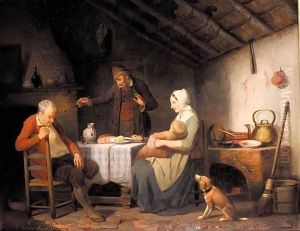Charles Venneman Paintings
Charles Venneman, whose full name is Charles-Louis Venneman, was a Belgian painter born on March 26, 1802, in Antwerp. He is often associated with the Romantic movement that was prevalent in European art during the early to mid-19th century. Venneman specialized in landscape and genre painting, capturing scenes of nature and everyday life with a particular focus on detailed and atmospheric depictions.
Venneman trained at the Royal Academy of Fine Arts in Antwerp, one of the most prestigious art schools in Belgium. His education there would have provided him with a strong foundation in the techniques and principles of fine art, influenced by the Romantic ideals of his time. His works often reflect the Romantic interest in nature, historical themes, and the common man's life, aligning with the broader European art trends of the era.
During his career, Venneman produced a body of work that included both rural and urban landscapes, showcasing his versatility and keen observation skills. He had a penchant for capturing the changing effects of light and atmosphere, which added a lyrical quality to his paintings. His genre scenes, on the other hand, depicted the daily lives of people, often imbued with a sense of narrative and character.
Charles Venneman exhibited his works in various salons and exhibitions, which helped to establish his reputation as an artist. His paintings were collected by art enthusiasts and patrons, contributing to the spread of his renown beyond his native Belgium. He was part of a generation of artists who were navigating the changes in the art world during the 19th century, as Romanticism gradually gave way to Realism and other emerging movements.
Venneman's contribution to Belgian art is recognized for its reflection of the Romantic spirit and his ability to capture the essence of his time through his landscapes and genre scenes. He passed away on March 26, 1875, in Antwerp, leaving behind a legacy of work that continues to be appreciated for its historical and artistic value. His paintings remain in private collections and museums, where they offer viewers a glimpse into the world of 19th-century Belgium and the Romantic era.




